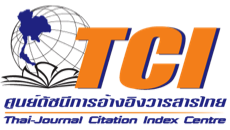การพัฒนาความสามารถในการแก้ปัญหาทางคณิตศาสตร์ด้วยการจัดการเรียนรู้แบบการสอนแนะ ให้รู้คิด (CGI) ร่วมกับเทคนิคเพื่อนคู่คิด (Think-Pair-Share) ของนักเรียนชั้นมัธยมศึกษาปีที่ 4 (The Development of Mathematics Problem Solving Ability through Cognitively Guided Instruction Approach and Think-Pair-Share of Matthayomsuksa 4 Students)
คำสำคัญ:
ความสามารถในการแก้ปัญหาทางคณิตศาสตร์ / การจัดการเรียนรู้แบบการสอนแนะให้รู้คิด / เทคนิคเพื่อนคู่คิดบทคัดย่อ
การวิจัยในครั้งนี้มีวัตถุประสงค์เพื่อ 1) เปรียบเทียบความสามารถในการแก้ปัญหาทางคณิตศาสตร์ก่อนและหลังเรียนด้วยการจัดการเรียนรู้แบบการสอนแนะให้รู้คิดร่วมกับเทคนิคเพื่อนคู่คิด 2) ศึกษาความคิดเห็นของนักเรียนที่มีต่อการจัดการเรียนรู้แบบการสอนแนะให้รู้คิดร่วมกับเทคนิคเพื่อนคู่คิด กลุ่มตัวอย่างคือ นักเรียน ชั้นมัธยมศึกษาปีที่ 4 โรงเรียนรัตนโกสินทร์สมโภชบวรนิเวศศาลายา ในพระสังฆราชูปถัมภ์ จำนวน 1 ห้องเรียน จำนวนนักเรียน 34 คน โดยการสุ่มอย่างง่าย โดยใช้ห้องเรียนเป็นหน่วยสุ่ม เครื่องมือที่ใช้ในการวิจัย คือ 1) แผนการจัดการเรียนรู้ 2) แบบวัดความสามารถในการแก้ปัญหาทางคณิตศาสตร์ 3) แบบสอบถามความคิดเห็นของนักเรียนชั้นมัธยมศึกษาปีที่ 4 ที่มีต่อการจัดการเรียนรู้แบบการสอนแนะให้รู้คิดร่วมกับเทคนิคเพื่อนคู่คิดการวิเคราะห์ข้อมูลใช้ค่าเฉลี่ย ค่าส่วนเบี่ยงเบนมาตรฐาน และสถิติทดสอบทีแบบไม่เป็นอิสระต่อกัน ผลการวิจัยพบว่า 1) ความสามารถในการแก้ปัญหาทางคณิตศาสตร์ของนักเรียนชั้นมัธยมศึกษาปีที่ 4 หลังเรียนด้วยการจัดการเรียนรู้แบบการสอนแนะให้รู้คิดร่วมกับเทคนิคเพื่อนคู่คิดสูงกว่าก่อนเรียน อย่างมีนัยสำคัญทางสถิติที่ระดับ .05 2) ความคิดเห็นของนักเรียนชั้นมัธยมศึกษาปีที่ 4 ที่มีต่อการจัดการเรียนรู้แบบการสอนแนะให้รู้คิดร่วมกับเทคนิคเพื่อนคู่คิดมีความคิดเห็นในภาพรวมอยู่ในระดับมาก
เอกสารอ้างอิง
2. Angganapattarakajorn, V. (2013). “Development of Statistical Reasoning and Connecting Mathematics to Real Life Using Instructional Activities Based on Cognitively Guided Instruction and Higher Order Questions for Grade 6 Students”. Journal of Education Burapha University 24(2): 15-33. (in Thai)
3. Auipa-aech, C. (2009). Effects of Using Cognitively Guided Instruction Approach in Organizing Mathematics Learning Activities on Mathematics Problem Solving Ability and Attitudes Towards Mathematics of Eighth Grade Students. Master of Education Thesis Program in Mathematics Education Department of Curriculum Instruction and Educational Technilogy Faculty of Education Chulalongkorn University. (in Thai)
4. Bureau of Educational Testing. (2019). Report of National Educational Testing Foundation (O-NET), Mathayomsuksa 6, Academic Year 2018. [Online]. Retrieved June 16, 2019, from https://niets.or.th.
5. Carpenter et al. (1989). “Using Knowledge of Childern’ s Mathematics Thinking in Classroom Teaching: An Experimental Study”. American Educational Research Journal 26(4):499- 531. [Online]. Retrieved May 6, 2019, from https://www.jstor.org/stable/1162862?seq=1.
6. Dachakupl, P. & Yindeesuk, P. (2008). 5C Skills for unit development and learning Manage teaching and learning integrated. Bangkok: Chulalongkorn University Press. (in Thai)
7. Daoruang, S. (2012). Development of a Blended Learning Model using Activity-Based Learning and a Think Pair Share Technique on a Wiki to Enhance the Creative Problem-Solving Ability of Ninth Grade Students. Master of Education Thesis Program in Educational Technology and Communications Department of Educational Technology and Communications Faculty of Education Chulalongkorn University. (in Thai)
8. Dencha, T. (2015). “Students’ mathematical understanding levels on exponent in classroom using taught by open approach”. Varidian E-Journal, Silpakorn University 8(2):1719- 1734. [Online]. Retrieved May 12, 2019, from https://he02.tci-thaijo.org/index.php/Veridian-E-Journal/article/view/40433. (in Thai)
9. Department of Curriculum and Instruction Development. (2002). Research for learning development based on basic education curriculum. Bangkok: Express Transportation Organization of Thailand. (in Thai)
10. Hanna, G. & Yackel, E. (2003). Reasoning and Proof. in A Research Companion to Principles and Standards for School Mathematics. Kilpatrick, J., Martin, G.W. & Schifter, D. Editors. Reston, VA: National Council of Teacher of Mathematics.
10. Kajornjit, S. (2015). The Effects of Cognitive Guided Instruction Activities Integrated with Graphic Organizer Techniques on Mathematical Concept and The Communication Abilities of Mathematics Interpretation and Presentation in Probability of Fifth Grade Students. Master of Education Thesis Program in Department of Curriculum and Instruction Naresuan University. (in Thai)
11. Kagan, S. (1994). Cooperative Learning. New York: Publisher: Resources for Teachers.
12. Khammanee, T. (2008). Science of knowledge teaching for organizing learning processes that are Efficiency. Bangkok: Chulalongkorn University Press. (in Thai)
13. Kristin, L. G., and Bradley, D. R. (2008). Using Simple Cooperative Learning Techniques in a Plant Propagation course. Michigan State University.
14. Kumkuan, S. (2016). Effects of Organizing Activities by using the Model Method and Cognitively Guided Instruction on Mathematical Problem Solving Ability of Eighth Grade Students the Effects of Cognitive Guided Instruction Activities on Mathematical Connection Skills and Learning Achievement in Surface Areas and Volumes of Mathayomsuksa 3 Students, Piboonbumpen Demonstration School.
15. Master of Education Thesis Program in Mathematics Teaching Faculty of Education Burapa University. (in Thai)
16. Ministry of Education. (2008). The Basic Education Core Curriculum B.E. 2551 (A.D. 2008). Bangkok: The Agricultural Cooperative Federation of Thailand. Limited. (in Thai)
17. Moonkum, S. & Moonkum, O. (2002). 19 Learning management methods: to develop knowledge and skills. Bangkok: Parbpim Printing. (in Thai)
18. National Center for Resrarch in Mathematics and Science Education. (1992). Cognitively Guided Instruction. NCRMSE Research Review 1(2).
19. Pakpiankij, T. (2015). Effects of Organizing Activities by using The Model Method and Cognitively Guided Instruction on Mathematical Problem Solving Ability of Eighth Grade Students. Master of Education Thesis Program in Mathematics Education Department of Curriculum and Instruction Faculty of Education Chulalongkorn University. (in Thai)
20. Palawan, A. (2013). The Effects of Cognitively Guided Instruction Activities in Probability upon Mathematics Learning Achievement, Mathematical Problem Solving Ability Metacognition Awareness and Self-Discipline of Mathayomsuksa V Students. Master of Education Thesis Program in Secondary Education Srinakharinwirot University. (in Thai)
21. Promrak, M. (2013). Effects of Organizing Mathematics Learning Activities Using the Problem Solving Model of Metacognitive Process on Mathematics Problem Solving and Critical Thinking Ability of Eighth Grade Students. Master of Education Thesis Program in Mathematics Education Department of Curriculum and Instruction Faculty of Education Chulalongkorn University. (in Thai)
22. Samattakarn, S. (2013). The Effects of Learning Cognitive Guided Instruction in Permutations and Combinations on Mathematics Achievement, Mathematical Problems Solving Ability and Mathematical Connection Ability of Mathayomsuksa VI Students. Master of Education Thesis Program in Secondary Education Srinakharinwirot University. (in Thai)
23. Sampsel, A. (2013). Finding the Effects of Think-Pair-Share on Student Confidence and Participation. Honors Projects.
24. Sounsumran, B. (2011). The Development of Learning Outcomes and Analytical Thinking Skills of The Fifth Grade Students taught by KWLH Plus Technique with Think-Pair-Share. Master of Education Thesis Program in Department of Curriculum and Instruction Faculty of Education Silpakorn University. (in Thai)
25. Tangsriseree, S. (2013). Effects of Organizing Mathematics Learning Activities using the Guide Discovery Method and Think-Pair-Share Technique on the Mathematical Communication and Connection Ability of Eighth Grade Students. Master of Education Thesis Program in Mathematics Education Department of Curriculum and Instruction Faculty of Education Chulalongkorn University. (in Thai)





